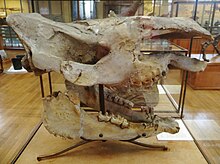Pliorhinus
| Pliorhinus Temporal range:
| |
|---|---|

| |
| Skull of Pliorhinus megarhinus | |
| Scientific classification | |
| Domain: | Eukaryota |
| Kingdom: | Animalia |
| Phylum: | Chordata |
| Class: | Mammalia |
| Order: | Perissodactyla |
| Family: | Rhinocerotidae |
| Subtribe: | Rhinocerotina |
| Genus: | †Pliorhinus Pandolfi et al., 2021 |
| Species | |
| |
Pliorhinus is an extinct genus of rhinoceros known from the Late Miocene and Pliocene of Eurasia. The type species, Pliorhinus megarhinus, was previously assigned to Dihoplus.
Taxonomy[edit]
The genus was named in 2021 to accommodate two species that had previously been included in a wide variety of rhinoceros genera, including Dihoplus and Stephanorhinus.[1]
- P. megarhinus (de Christol, 1834) known from the Late Miocene-Pliocene of Europe, Anatolia, and Transbaikalia.[2][3]
- P. miguelcrusafonti (Guérin & Santafé-Lopis, 1978) known from the Pliocene of Europe
- P. ringstoemi (Arambourg, 1959), Late Miocene of China. (previously synonymised with P. megarhinus,[2] but now regarded as distinct[4])
Species of Pliorhinus are medium-large sized two horned rhinoceroses, which have a nasal notch located above the molars, and are distinguished from other rhinoceroses by various characters of the teeth. P. megarhinus is noted for having a relatively flat skull roof.[1] Species of Pliorhinus are suggested to be closely related and possibly ancestral to Stephanorhinus.[5]
Morphological phylogeny after Pandolfi (2023), excluding living African rhinoceros species.[5]
| |||||||||||||||||||||||||||||||||||||||||||||||||||||||||||||||||||||||||||||||||||||||||||||||||||||||||||||||||||||||||||||||||||||||||||||||||||||||||||||
Ecology[edit]
P. megarhinus is suggested to have been a browser or mixed feeder.[6]
References[edit]
- ^ a b Pandolfi, Luca; Pierre-Olivier, Antoine; Bukhsianidze, Maia; Lordkipanidze, David; Rook, Lorenzo (2021-08-03). "Northern Eurasian rhinocerotines (Mammalia, Perissodactyla) by the Pliocene–Pleistocene transition: phylogeny and historical biogeography". Journal of Systematic Palaeontology. 19 (15): 1031–1057. Bibcode:2021JSPal..19.1031P. doi:10.1080/14772019.2021.1995907. ISSN 1477-2019. S2CID 244762077.
- ^ a b Pandolfi, Luca; Gasparik, Mihály; Piras, Paolo (2015). "Earliest occurrence of "Dihoplus" megarhinus (Mammalia, Rhinocerotidae) in Europe (Late Miocene, Pannonian Basin, Hungary): Palaeobiogeographical and biochronological implications". Annales de Paléontologie. 101 (4): 325–339. Bibcode:2015AnPal.101..325P. doi:10.1016/j.annpal.2015.09.001.
- ^ Pandolfi, Luca; Rivals, Florent; Rabinovich, Rivka (January 2020). "A new species of rhinoceros from the site of Bethlehem: 'Dihoplus' bethlehemsis sp. nov. (Mammalia, Rhinocerotidae)". Quaternary International. 537: 48–60. Bibcode:2020QuInt.537...48P. doi:10.1016/j.quaint.2020.01.011. S2CID 213080180.
- ^ Li, Shijie; Sanisidro, Oscar; Wang, Shiqi; Yang, Rong; Deng, Tao (March 2024). "New materials of Pliorhinus ringstroemi from the Linxia Basin (Late Miocene, eastern Asia) and their taxonomical and evolutionary implications". Journal of Mammalian Evolution. 31 (1). doi:10.1007/s10914-023-09698-w. ISSN 1064-7554. S2CID 267352083.
- ^ a b Pandolfi, Luca (April 2023). "Reassessing the phylogeny of Quaternary Eurasian Rhinocerotidae". Journal of Quaternary Science. 38 (3): 291–294. Bibcode:2023JQS....38..291P. doi:10.1002/jqs.3496. hdl:11563/163194. ISSN 0267-8179.
- ^ Ballatore, Manuel (2016). "Palaeoecological investigations on Plio-Pleistocene European rhinoceroses (Genus Stephanorhinus): powder X-ray diffraction, carbon isotope geochemistry, tooth wear analyses and biometry". Plinius (42): 16–19. doi:10.19276/plinius.2016.01001. ISSN 1972-1366.
